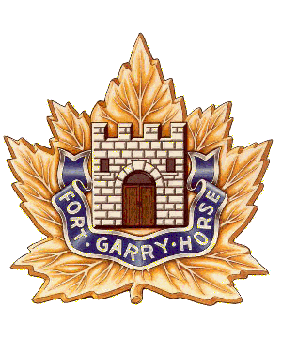
The Canadian Grenadier Guards (CGG) is a reserve infantry regiment in the 34 Canadian Brigade Group, 2nd Canadian Division, of the Canadian Army. The regiment is the oldest and second-most-senior infantry regiment in the Primary Reserve of the Canadian Army. Located in Montreal, its main role is the provision of combat-ready light infantry troops in support of Canadian regular infantry. It is a Household Foot Guard regiment and also provides soldiers for public ceremonial duties, performing similar ceremonial duties as the Guards regiments of the British Army. This primarily entails mounting the guard at Government House, the King's and Governor General's residence, and performing the "Changing the Guard" ceremony on Parliament Hill in Ottawa, a task it shares with Canada's senior Household Foot Guard regiment, the Governor General's Foot Guards of Ottawa. The Canadian Grenadier Guards is an allied regiment to the British Grenadier Guards.
The Canadian Expeditionary Force (CEF) was the expeditionary field force of Canada during the First World War. It was formed on August 15, 1914 following Britain’s declaration of war on the German Empire, with an initial strength of one infantry division. The division subsequently fought at Ypres on the Western Front, with a newly raised second division reinforcing the committed units to form the Canadian Corps. The CEF and corps was eventually expanded to four infantry divisions, which were all committed to the fighting in France and Belgium along the Western Front. A fifth division was partially raised in 1917, but was broken up in 1918 and used as reinforcements following heavy casualties.

The Royal Hamilton Light Infantry (Wentworth Regiment) (RHLI) is a Primary Reserve infantry regiment of the Canadian Army, based at John Weir Foote VC Armoury in Hamilton, Ontario. The RHLI is part of 31 Canadian Brigade Group, which is part of 4th Canadian Division.

The Fort Garry Horse is a Canadian Army Reserve armoured regiment based in Winnipeg, Manitoba, Canada. It is part of 3rd Canadian Division's 38 Canadian Brigade Group. It traces its history to a cavalry regiment first formed in 1912 that first took up the name "Fort Garry" a year afterwards. Since that time the regiment has served in the First World War, sending men to battalions of the Canadian Expeditionary Force, and as an armoured regiment in the Second World War.

The Royal Highland Fusiliers of Canada is a Primary Reserve light infantry regiment of the Canadian Army, with companies in Cambridge and Kitchener, and is an infantry sub-unit of 31 Canadian Brigade Group, headquartered in London, Ontario. The Princess Margaret, Countess of Snowdon, and The Prince Andrew, Duke of York, as members of the Canadian Royal Family, acted as Colonel-in-Chief.

The Lorne Scots is a Primary Reserve infantry regiment of the Canadian Army. It is part of the 4th Canadian Division's 32 Canadian Brigade Group.

The Brockville Rifles is a Primary Reserve infantry regiment of the Canadian Army. The unit is a part of the 33 Canadian Brigade Group, 4th Canadian Division. It is fifteenth in the order of precedence of Canadian Army Infantry Regiments.

The 20th Battalion, CEF was a unit of the First World War Canadian Expeditionary Force.
The 126th Battalion (Peel), CEF was a unit in the Canadian Expeditionary Force during the First World War. Based in Toronto, Ontario, the unit began recruiting in late 1915 in Peel County. After sailing to England in August 1916, the battalion was absorbed into the 109th and 116th Battalions, CEF, and the 8th Reserve Battalion on October 13, 1916. The 126th Battalion (Peel), CEF, had one Officer Commanding: Lieut-Col. F. J. Hamilton.

The Non-Permanent Active Militia (NPAM) was the military reserve force of Canada from 1855 to 1940. It was composed of several dozen infantry battalions and cavalry regiments. After the withdrawal of British forces from Canada during the turn of the 20th century, supporting corps were created in Canada as part of both the PAM and the NPAM.
The 248th Battalion, CEF was a unit in the Canadian Expeditionary Force during the First World War. Based in Owen Sound, Ontario, the unit began recruiting in the late summer of 1916 in Grey County. After sailing to England in June 1917, the battalion was absorbed into the 7th and 8th Reserve Battalions later that month. The 248th Battalion, CEF had one Officer Commanding: Lieut-Col. Joseph Hilliard Rorke.

The 5th Battalion Canadian Mounted Rifles were a mounted infantry unit of the Canadian Expeditionary Force (CEF) during World War I. The unit was raised from volunteers of the 7th and XIth (Canadian) Hussars from the Eastern Townships of Quebec.

The Victoria Rifles of Canada was an infantry regiment of the Non-Permanent Active Militia of the Canadian Militia and later the Canadian Army. First formed in Montreal, Canada East, in 1862, the regiment saw a history of service stretching from the Fenian Raids of the 1860s–1870s into the middle of the 20th century. In 1965, the regiment was reduced to nil strength and transferred to the Supplementary Order of Battle.

The 7th Battalion, CEF was a battalion of the Canadian Expeditionary Force that saw service in the First World War.
The 50th Field Artillery Regiment, Royal Canadian Artillery was a Canadian Army Reserve artillery regiment based in Peterborough, Ontario. The regiment exists "on paper" on the Supplementary Order of Battle.

The 47th Battalion, CEF, was an infantry battalion of the Canadian Expeditionary Force during the Great War.

The 73rd Battalion, CEF was an infantry battalion of the Canadian Expeditionary Force during the Great War. The 73rd Battalion organized in June 1915, initially commanded by Lieutenant-Colonel Peers Davidson, was placed on 'Active Service' as an 'Overseas Battalion', on 10 July 1915, as authorized in Militia General Orders.

The Otter Commission, or Otter Committee, was established after the First World War to tackle a problem created by the chaotic mobilization of the Canadian Expeditionary Force. In 1919, units of the CEF, intended as a wartime expeditionary force, returned to Canada where the Canadian Militia had served during the war performing home defence duties, staffing internment camps, and raising recruits for overseas. Both the CEF and the Militia desired to be perpetuated in the post-war world. The CEF units were proud of their wartime record, while the pre-war Militia had long-standing roots in the community and battle honours dating back as far as the War of 1812.
The Victoria and Haliburton Regiment was an infantry regiment of the Non-Permanent Active Militia of the Canadian Militia. In 1936, the regiment was converted from infantry to artillery to become the 45th Field Battery RCA and now forms part of the 50th Field Artillery Regiment, RCA.
The Peterborough Rangers was an infantry regiment of the Non-Permanent Active Militia of the Canadian Militia. In 1936, the regiment was amalgamated with the 3rd Prince of Wales' Canadian Dragoons to form The Prince of Wales Rangers.














